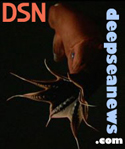SOS and Inverts in the the Top 10
The International Institute for Species Exploration (IISE) released their first ever State of Species report on Friday (to be issued annually on May23rd, the birthdate of Linnaeus). Pouring through the journal reports and monographs from 2006, the IISE found 16,969 new species (not counting any new microbes) described in that year. Invertebrates accounted for 13,900 of the 14,912 new animal species. That's 93% of new animal species and 82% of total new species described in 2006. (And, yes, insects accounted for over half the new species by themselves)

They also announced their Top Ten new species described in 2007. Three inverts made the cut of the selection committee of 12 experts from around the world headed by Dr. Janine Caira of UCONN.
The selected inverts in the top ten are:

At #9 there is Megaceras briansaltini, a rhinoceros beetle from Peru described as being a case of nature imitating art, as this beetle bears a "striking resemblance" (save the color) to Dim from Pixar's animated hit "A Bug's Life".
Ratcliffe, B.C. 2007. A remarkable new species of Megaceras from Peru (Scarabaeidae: Dynastinae: Oryctini). The “Dim Effect”: Nature mimicking art. The Coleopterists Bulletin 61(3): 463-467. DOI:10.1649/0010-065X(2007)61[463:ARNSOM]2.0.CO;2

The deadly Malo kingi appears at #8, this Irukandji (a type of Cubozoan jelly) is named after one of its most famous fatal encounter victims, Robert King. So exactly how does one study a tiny, highly lethal, almost transparent marine jelly anyway??? Any cubozoa experts out there?
Gershwin, L.A. 2007. Malo kingi: A new species of Irukandji jellyfish (Cnidaria: Cubozoa: Carybdeida), possibly lethal to humans, from Queensland, Australia. Zootaxa 1659: 55-68.

Crawling in at #3 is Desmoxytes purpurosea (a.k.a. shocking pink dragon millipede), showing Diplopoda's brighter side in a bright coral pink. It doesn't hide it either, resting in the open and on vegetation during the day in its native Thailand.
H. Enghoff, C. Sutcharit & S. Panha. 2007. The shocking pink dragon millipede, Desmoxytes purpurosea, a colourful new species from Thailand (Diplopoda: Polydesmida: Paradoxosomatidae). Zootaxa 1563: 31-36.
Hopefully this annual release will continue. Considering the various Census of Life projects under way, the job of the compilers will not be easy! Of course, the top ten list is highly subjective, as they readily admit. Marine life, in addition to inverts in general, seem woefully under represented with one marine invert (malo kingi) and one marine vertebrate, the electric ray (representing an entirely new genus, named after a vacuum cleaner - Electrolux addisoni).
Maybe we should team up with DSN and pick a top ten new marine species at some point. Kevin?






















